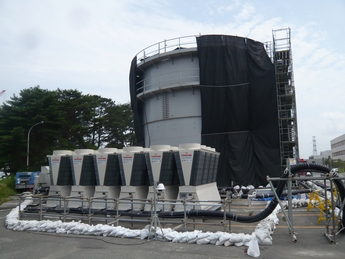TEPCO has installed cooling equipment to lower the temperature of cooling water circulating in the units 1, 2 and 3 reactor buildings.

Warm summer conditions at the Fukushima Daiichi site could raise reactor pressure vessel ambient temperatures to 65°C, according to current projections (RPV bottom temperatures are currently 36.5°C, 48.8°C and 48.4°C for units 1, 2 and 3). Water returning from the reactor buildings at a rate of 30 m3/hr to the treatment water buffer tank is 33°C. The system takes water from this tank at a rate of 60m3/hr and cools it by seven degrees, enabling the water injected back into the reactors to be cooled to 19°C. The cooling effect will avoid needing to increase the amount of water pumped into the reactors. Ambient temperatures are expected to stabilise in about a week, at which point water injection will be reduced.
A crane has lowered a camera to film elevations of the wreckage of the former fifth floor of Fukushima Daiichi unit 3, which was destroyed by an explosion in March 2011. A camera was also lowered down the equipment hatch to examine wreckage in the third and fourth floors. The footage will be used for decontamination planning.
Next door, TEPCO workers have finished removing debris above the unit 4 refuelling floor, in preparation to fit a cover over the reactor building.
An expedition to the Fukushima Daiichi unit 1 traversing incore probe (TIP) room was unusual in that all three participants were robots. The first challenge that the expedition's members had to overcome was a locked door. Robot videos show one robot inserting a key in the lock, and turning it, and later turning the handle to open the door. Once inside, radiation levels were again found to be very high: ranging from a low of about 100 mSv/hr up to extreme highs near a floor penetration (5150 mSv/hr) and the upper part of an equipment funnel (2070 mSv/hr). The rates are comparable with those taken in October 2011.
Radiation rates were taken at two heights above the floor: an elevation of 150cm (5 ft) than at floor level (15 cm). Where obstacles did not block measurements, rates were always greater at the higher elevation.
Desalination of the unit 2 spent fuel pool has ended, after about six months of work. The process has lowered chloride concentrations from 1600 ppm to 11 ppm. The procedure went in three steps: first, caesium removal (starting in November 2011), second, desalination with reverse osmosis (19 January 2012-12 April 2012), third, desalination with the ion-exchange system on 12 April 2012.




